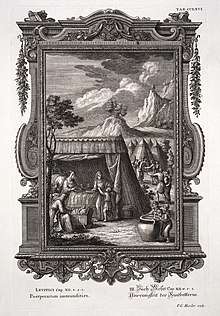Impurity after childbirth
Impurity after childbirth is a form of impurity, primarily found in Abrahamic religions, that begins after a woman has given birth. It is connected to the seclusion imposed by the expectations of postpartum confinement.

Biblical law on impurity after childbirth
According to Leviticus 12, a woman who gives birth to a son remains impure for a week, and afterwards immerses in a body of water to purify herself. In rabbinical interpretation of Leviticus 12 any subsequent blood she sees over the next 33 days would be considered dam tohar (דַּם טׂוהַר – ritually clean blood), and that blood does not prohibit her from sexual relations with her husband. The law for a woman who gives birth to a daughter is the same, however, the durations are doubled. The mother becomes impure for 2 weeks, and after immersion, any blood she sees over the next 66 days is dam tohar.
Scholarly explanation
There is no scholarly consensus for the Biblical law, including the difference between the birth of sons and daughters. Tikva Frymer-Kensky suggested that "like the person who touched death, the person who has experienced birth has been at the boundaries of life/non-life...."[1]
Other rationales include moments of crisis or danger, fear of demons, health, and a lack of wholeness.[2]
For an attempt at a scientific explanation (re: toxicity of post-puerperal blood) at the duration of the impurity, with attention to related impurity practices in other cultures with differential treatment by newborn gender (e.g., Cich Indians and aboriginal groups in Egypt and Central Africa).[3]
Jewish law and practices
Within the realm of Biblical law and post-Biblical Jewish religious discourse surrounding tumah and taharah, the impurity is called in Hebrew tumat yoledet. Halakhah treats a yoledet (woman who gives birth) similarly to any woman with niddah status.
In some Jewish communities, ceremonies and a degree of seclusion were applied to postparturient women. For example, there was a Sana Yemenite custom of women visiting the mother during 4–6 weeks after childbirth. The mother would be visited in a special room in her home and she would sit in a decorated triangle box.[4]
Christian practices
Some early churches followed the Jewish custom of restricting women from worship after giving birth until the purification ceremony.[5][6] Today, many Christians commemorate Candlemas, the feast of the purification of the Virgin Mary. Some continue to celebrate a Churching of Women ceremony, derived from the Jewish tradition but not necessarily implicating ritual impurity.[7][8]
Sikhism
Sikhism condemns the practice of considering women as impure after childbirth. There are many references in Guru Granth Sahib against this practice and refer to purity in regards to higher living, not just washing the body or refraining from eating with others.[9][10] For example, in the following hymn of Guru Granth Sahib, Guru Nanak questions the belief of ritual impurity.
If one accepts the concept of impurity, then there is impurity everywhere. In cow-dung and wood there are worms. As many as are the grains of corn, none is without life. First, there is life in the water, by which everything else is made green. How can it be protected from impurity? It touches our own kitchen. O Nanak, impurity cannot be removed in this way; it is washed away only by spiritual wisdom.
— Guru Nanak, Guru Granth Sahib 472 [11]
See also
- Menstrual taboo
- Postpartum depression
References
- p. 401
- Milgrom, Jacob (1993). "The rationale for biblical impurity" (PDF). Journal of the Ancient Near Eastern Society. 22 (1).
- Macht, David I. (1933). "A scientific appreciation of Leviticus 12: 1-5". Journal of Biblical Literature: 253–260. JSTOR 3259207.
- Goldberg, Harvey (2003). Jewish passages: cycles of Jewish life. Univ. of California. pp. 64–65.
- Susan K. Roll, "The Old Rite of Churching Women after Childbirth, in De Troyer, Kristin, ed. (2003). Wholly woman, holy blood: a feminist critique of purity and impurity. Harrisburg, PA: Trinity Press International. ISBN 9781563384004.
- Newell, Rachel C. "The thanksgiving of women after childbirth: a blessing in disguise." Exploring the Dirty Side of Women’s Health. London, New York (2007): 44-59.
- Cressy, David (1993). "Purification, Thanksgiving and the Churching of Women in Post-Reformation England". Past and Present. 141 (1): 106–146. doi:10.1093/past/141.1.106. JSTOR 651031.
- Knödel, Natalie (1997). "Reconsidering an Obsolete Rite: The Churching of Women and Feminist Liturgical Theology". Feminist Theology. 5 (14): 106–125. doi:10.1177/096673509700001406.
- http://www.sikhiwiki.org/index.php/Sutak
- Singh, Khazan (1970). History of the Sikh Religion,. Department of Languages, Punjab. p. 32.
- "Sri Granth: Sri Guru Granth Sahib".
- Cooper, Alan (October 2004). "A medieval Jewish version of original sin: Ephraim of Luntshits on Leviticus 12". Harvard Theological Review. 97 (4). doi:10.1017/S0017816004000781. JSTOR 4495099.
- Goldberg, Harvey E. Jewish passages: cycles of Jewish life. Univ of California Press, 2003.
- Magonet, Jonathan. "‘But If It Is a Girl, She Is Unclean for Twice Seven Days...’: The Riddle of Leviticus 12: 5." Reading Leviticus: A Conversation with Mary Douglas (1996): 144-52.
- Tikva Frymer-Kensky, “Pollution, Purification, and Purgation in Biblical Israel,” in The Word of the Lord Shall Go Forth: Essays in Honor of D. N. Freedman in Celebration of His Sixtieth Birthday (ed. C. L. Meyers and M. O’Connor; Winona Lake, Ind.: Eisenbrauns, 1983), 399–414